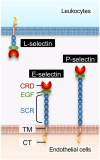Vascular E-selectin Expression Detected in Formalin-fixed, Paraffin-embedded Sections With an E-selectin Monoclonal Antibody Correlates With Ulcerative Colitis Activity
- PMID: 35253509
- PMCID: PMC8971687
- DOI: 10.1369/00221554221085336
Vascular E-selectin Expression Detected in Formalin-fixed, Paraffin-embedded Sections With an E-selectin Monoclonal Antibody Correlates With Ulcerative Colitis Activity
Abstract
It is widely accepted that E-selectin, an inducible endothelial cell adhesion molecule, plays a critical role in the initial step of neutrophil recruitment to sites of acute inflammation. However, immunohistological analysis of E-selectin has been hampered by lack of E-selectin-specific monoclonal antibodies that can stain formalin-fixed, paraffin-embedded (FFPE) tissue sections. Here, we employed E-selectin•IgM (a soluble form of E-selectin) as immunogen, and then, after negative selection with L-selectin•IgM and P-selectin•IgM and screening of FFPE sections of both COS-1 cells overexpressing E-selectin and acute appendicitis tissues, we successfully generated an E-selectin-specific monoclonal antibody capable of staining FFPE tissue sections. We used this antibody, designated U12-12, to perform quantitative immunohistological analysis of 390 colonic mucosal biopsy specimens representing ulcerative colitis. We found that the higher the histological disease activity, the greater the number of vessels expressing E-selectin, an observation consistent with previous analyses of frozen tissue sections. Furthermore, in active ulcerative colitis, E-selectin-expressing vessels contained neutrophils attached to endothelial cells, presumably in the process of extravasation, which eventually could cause epithelial damage. These results overall indicate that U12-12 is effective for E-selectin immunohistochemistry in archived FFPE samples representing various human diseases.
Keywords: carbohydrate-binding protein; colon; inflammatory bowel disease; lectin; sialyl Lewis x.
Conflict of interest statement
Figures







References
-
- Wellicome SM, Thornhill MH, Pitzalis C, Thomas DS, Lanchbury JS, Panayi GS, Haskard DO. A monoclonal antibody that detects a novel antigen on endothelial cells that is induced by tumor necrosis factor, IL-1, or lipopolysaccharide. J Immunol. 1990;144(7):2558–65. - PubMed
-
- Goda K, Tanaka T, Monden M, Miyasaka M. Characterization of an apparently conserved epitope in E- and P-selectin identified by dual-specific monoclonal antibodies. Eur J Immunol. 1999;29(5):1551–60. - PubMed
-
- Phillips ML, Nudelman E, Gaeta FC, Perez M, Singhal AK, Hakomori S, Paulson JC. ELAM-1 mediates cell adhesion by recognition of a carbohydrate ligand, sialyl-Lex. Science. 1990;250(4984):1130–2. - PubMed
Publication types
MeSH terms
Substances
LinkOut - more resources
Full Text Sources
Medical

